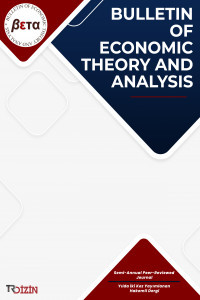Makro Ekonomik İstikrarsızlıklar ve Doğal İşsizlik Oranı: 1980-2016 OECD ve Türkiye Ekonomisi Örneği
İktisat literatüründe işsizliğin uzun dönem eğilimlerini açıklayan iki önemli görüş bulunmaktadır. Bunlardan ilki “doğal oran hipotezi” diğeri ise “histeri hipotezi” olarak bilinmektedir. Doğal oran hipotezine göre uzun dönemde işsizlik, doğal oranına ulaşacak ve bu oran üzerinde enflasyon ile işsizlik arasındaki değiş-tokuş ilişkisi sona erecektir. Kısa dönemde ise söz konusu değiş tokuş ilişkisi geçerli olacaktır. Histeri hipotezi yaklaşımı ise şokların işgücü piyasasındaki katılıklar nedeniyle işsizlik düzeyi üzerinde kalıcı etkilere sahip olduğunu ileri sürmektedir. İktisadi bir şoktan sonra işsizlik oranı eski seviyesinin çok üzerinde bir patikaya oturacaktır. Bu görüşe göre uzun süre yüksek işsizlik yaşanması doğal işsizlik oranının eski seviyesine dönmesine engel olacaktır. Bu çalışmada OECD ve Türkiye ekonomisi için 1980-2016 yılları arasında işsizlik oranına karşılık gelen enflasyon oranları arasındaki doğrusal ilişkiden hareketle doğal işsizlik oranı ekonometrik olarak hesaplanmaya çalışılmıştır. Elde edilen katsayılar istatiksel olarak anlamlı ve iktisat teorisiyle uyumlu işaretlere sahiptir. Söz konusu dönemde Türkiye ekonomisi için doğal işsizlik oranı %9.14 seviyesinde hesaplanmıştır. OECD ülkeleri için ise İşsizlik oranı %1 puan artığında enflasyon oranı söz konusu dönem için ortalama olarak %0.9 puan azalmıştır. Doğal işsizlik oranı ise OECD ülkeleri için %6.12 olarak hesaplanmıştır. Bu sonuçlar aynı zamanda söz konusu ülkeler için enflasyon ile işsizlik arasındaki ödünleşmeyi gösteren Philips Eğrisi’ nin katsayılarını göstermektedir.
Anahtar Kelimeler:
Doğal İşsizlik Oranı, Enflasyon Oranı, Phillps Eğrisi, Histeri Hipotezi, Makroekonomik İstikrar
Macroeconomic Unstables and the Rate of Natural Unemployement: The Study of OECD and Turkish Economy 1980-2016
There are two important views in the economics literature that explain the long-term trends of unemployment. The first one is known as "natural rate hypothesis” and the other one is known as "Hysteresis Hypothesis". According to natural rate hypothesis, long-term unemployment will reach its natural rate, and the trade-off between inflation and unemployment will end up on this rate. In the short term, that trade-off relationship will be valid. The hysteresis hypothesis approach claims that shocks have lasting effects on the level of unemployment due to rigidities in the labor market. The unemployement rate will go up to a very high level above the old level after an aconomic shock. According to this opinion, being of long term unemployement will prevent the natural rate of unemployment from returning to its former level. In this study, is aimed to calculate natural rate of unemployment econometric based on the linear relationship between inflation rates corresponding to the unemployment rate for OECD and Turkey between 1980-2016. The finding coefficients are significant statistically and have signs compatible with the theory of economics. In this period natural rate of unemployment for Turkey's economy was calculated 9.14%. For the OECD countries, the unemployment rate increased by 1 percentage point and the inflation rate decreased by 0.9 percentage points on average for the mentioned period. The natural rate of unemployment was calculated as 6.12% for OECD countries. These results are also showing Philips Curve coefficients as tradeoff between inflation and unemployment for Turkey and OECD.
Keywords:
Natural Rate of Unemployement, Inflation Rate, Philips Curve, Hysteresis Hypothesis, Macroeconomic Unstables,
___
- Barro, R. (1988). The Natural Rate Theory Reconsidered: The Persistence of Unemployment. American Economic Review,78(2). 32-37
- Blanchard, O. (2017), Macroeconomics, 7th Edition. Pearson
- Blanchard, O. J., & Summers, L. H. (1986). Hysteresis and the European unemployment problem. NBER Macroeconomics Annual, 1, 15-78.
- Botrić, V. (2012). NAIRU Estimates for Croatia. Zbornik Radova Ekonomskog Fakultet au Rijeci. 30(1),163-180.
- Duygulu, A. A. (1998). Döviz kuru istikrarının ekonomik istikrar açısından değerlendirilmesi. Dokuz Eylül Üniversitesi İİBF Dergisi, 13(1), 107-118.
- Estrada, A., Hernando, I., López-Salido, J. D., Bonilla, J. M., García-Perea, P., & Vallés, J. (2000). Measuring the NAIRU in the Spanish Economy (No. 0009). Banco de España.
- Ferreira, A., Aguirre, A., & Gomes, F. (2003). Estimates of the NAIRU for Brazil using the Ball-Mankiw approach. Série CEPE Working Paper
- Gordon, R. J. (1997). The time-varying NAIRU and its implications for economic policy. Journal of economic Perspectives, 11(1), 11-32.
- Gujarati, D. N. (2009). Basic Econometrics. Tata McGraw-Hill Education.
- Güloğlu, B., & İspir, M. S. (2011). Doğal İşsizlik Oranı mı? İşsizlik Histerisi mi? Türkiye İçin Sektörel Panel Birim Kök Sınaması. Ege Akademik Bakış, 11(2), 205-215.Kahyaoğlu, H., Tuzun, O., Ceylan, F., & Ekinci, R. (2016). İşsizlik Histerisinin Geçerliliği: Türkiye ve Seçilmiş AB Ülkeleri Üzerine Bir Uygulama. Manisa Celal Bayar Üniversitesi Sosyal Bilimler Dergisi, 14(4), 103-128.
- Layard, R., Nıckell, S. & Jackman, R. (1991). Macroeconomic Performance and the Labour Market. Oxford: Oxford University Press.
- Logeay, C., & Tober, S. (2006). Hysteresis and the NAIRU in the Euro Area. Scottish Journal of Political Economy, 53(4), 409-429.
- Madsen, J. B. (2005). Empirical estimates of the NAIRU. Labour, 19(3), 563-593.
- OECD (2017), OECD Employment Outlook 2017, OECD Publishing, Paris. http://dx.doi.org/10.1787/empl_outlook-2017-en (10.03.2018).
- Pesaran, M. H. (2004). General Diagnostic Tests for Cross Section Dependence in Panels' IZA Discussion Paper No. 1240.
- Schumacher, C. (2008). Measuring uncertainty of the euro area NAIRU: Monte Carlo and empirical evidence for alternative confidence intervals in a state space framework. Empirical Economics, 34(2), 357-379.Temurlenk, M. S., & Başar, S. (2013). Türkiye İçin Enflasyonu Hızlandırmayan İşsizlik Oranı (Nairu) Tahmini. Dokuz Eylül Üniversitesi İktisadi ve İdari Bilimler Fakültesi Dergisi, 27(1).71-83.
- Tokatlıoğlu, İ., Öztürk, F., & Ardor, H. (2014). AB Ülkeleri ve Türkiye İşgücü Piyasasında Histeri Etkisi: RATCHET Modeli Analizi. Sosyoekonomi, 22(22), 298-320.
- Yayın Aralığı: Yılda 2 Sayı
- Başlangıç: 2016
- Yayıncı: Mehmet SONGUR
Sayıdaki Diğer Makaleler
Döviz Kurunun Yurt İçi Fiyatlara Geçiş Etkisinin Yumuşak Geçişli Regresyon Modeliyle Tahmini
Nazlı KARAOĞLU, Serdar KILIÇKAPLAN
Kredi Genişlemesinin Cari Açığa Etkisi: Türkiye Örneği
Makro Ekonomik İstikrarsızlıklar ve Doğal İşsizlik Oranı: 1980-2016 OECD ve Türkiye Ekonomisi Örneği
